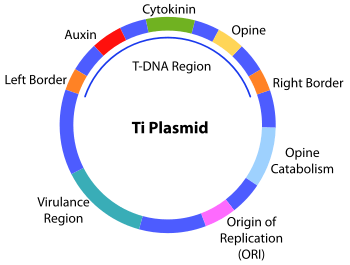Transfer DNA

The transfer DNA (abbreviated T-DNA) is the transferred DNA of the tumor-inducing (Ti) plasmid of some species of bacteria such as Agrobacterium tumefaciens and Agrobacterium rhizogenes. It derives its name from the fact that the bacterium transfers this DNA fragment into the host plant's nuclear DNA genome. The T-DNA is bordered by 25-base-pair repeats on each end. Transfer is initiated at the right border and terminated at the left border and requires the vir genes of the Ti plasmid.
The bacterial T-DNA is about 24,000 base pairs long[1][2] and contains genes that code for enzymes synthesizing opines and phytohormones. By transferring the T-DNA into the plant genome, the bacterium essentially reprograms the plant cells to grow into a tumor and produce a unique food source for the bacteria. The synthesis of the plant hormones auxin and cytokinin enables the plant cell to grow uncontrollably, thus forming the crown gall tumors typically induced by Agrobacterium infection. The opines are amino acid derivatives used by the bacterium as a source of carbon and energy.
T-DNA transformation
Agrobacterium-mediated T-DNA transfer is widely used as a tool in biotechnology. In genetic engineering, the tumor-promoting and opine-synthesis genes are removed from the T-DNA and replaced with a gene of interest and/or a selection marker, which is required to establish which plants have been successfully transformed. Examples of selection markers include neomycin phosphotransferase, hygromycin B phosphotransferase (which both phosphorylate antibiotics) and phosphinothricin acetyltransferase (which acetylates and deactivates phosphinothricin, a potent inhibitor of glutamine synthetase). Agrobacterium is then used as a vector to transfer the engineered T-DNA into the plant cells where it integrates into the plant genome. This method can be used to generate transgenic plants carrying a foreign gene.
Mechanism of T-DNA Transformation
The first step in integrating the T-DNA into a host genome is the formation of nick at the right border of the Ti plasmid. This nick creates a region of single stranded DNA from the left border of the T-DNA gene over to the right border which was cut. Single stranded binding proteins then attach to the single stranded DNA. DNA synthesis will displace the single stranded region and then a second nick at the left border region will release the single stranded T-DNA fragment. This fragment can then be incorporated into a host genome.
T-DNA mutagenesis
The same procedure of T-DNA transfer can be used to disrupt genes via insertional mutagenesis. Not only does the inserted T-DNA sequence create a mutation but it also 'tags' the affected gene, thus allowing for its isolation. This method is used widely to study gene function in plants, such as the model plant Arabidopsis thaliana.
See also
References
- P.H. Raven, R.F. Evert, S.E. Eichhorn (2005): Biology of Plants, 7th Edition, W.H. Freeman and Company Publishers, New York, ISBN 0-7167-1007-2